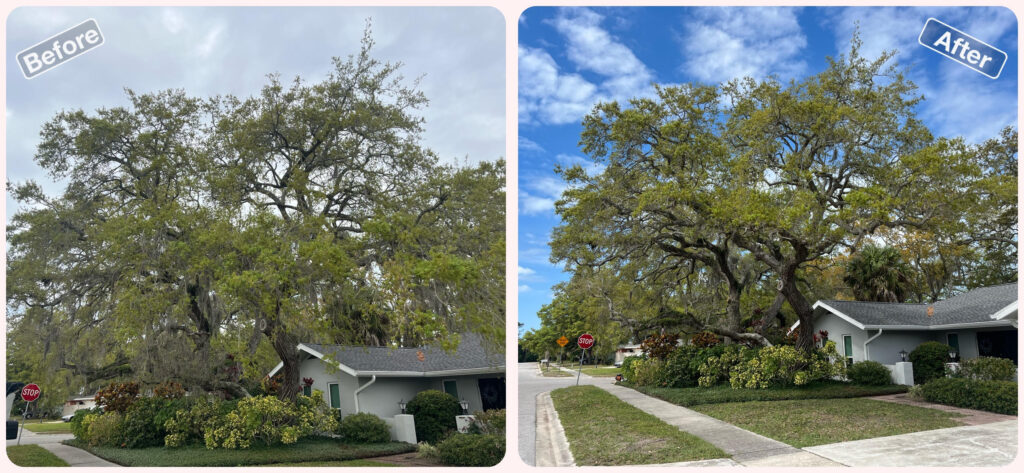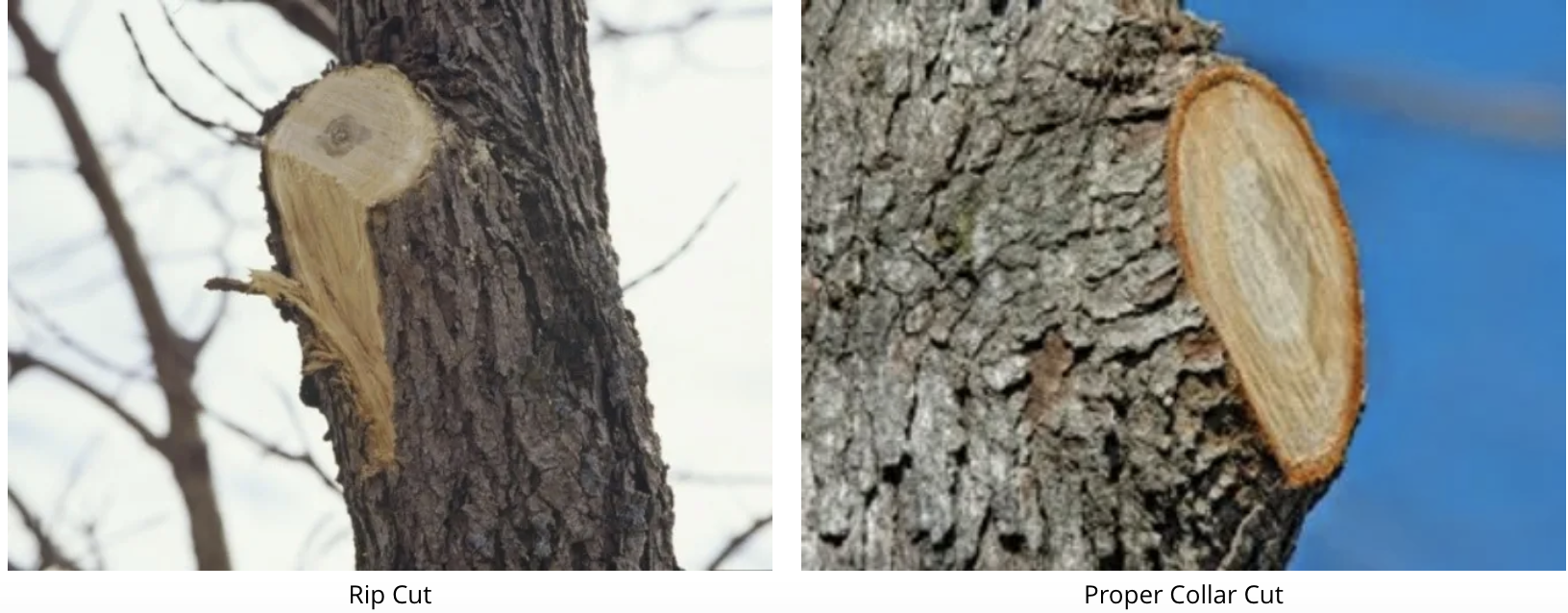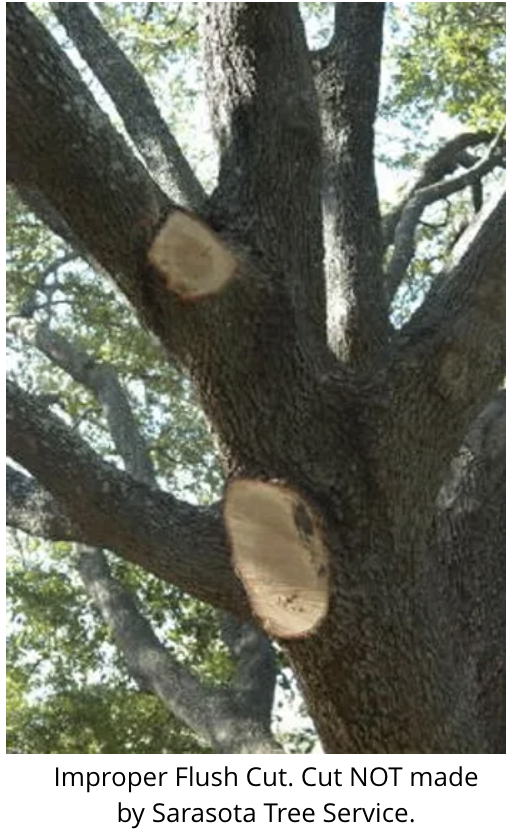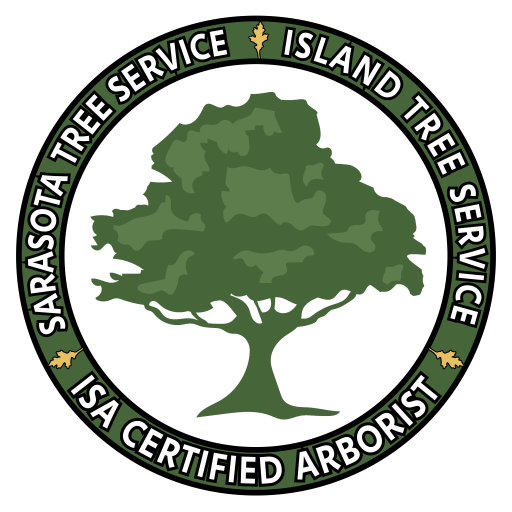LEARN ABOUT IMPROPER PRUNING TECHNIQUES
Improper Pruning – What to look for?
“Pruning is a double-edged sword, either helping or hurting according to if, where, when, how, and why it is applied. When properly executed, a variety of benefits can occur. Benefits include reducing risk of branch and stem breakage, preserving health, better clearance for vehicles and pedestrians, improved appearance, enhanced view, and increased flowering. When improperly performed, pruning can harm the tree’s health, stability, and appearance.”
– University of Florida
BE CAREFUL
In Sarasota, proper pruning methods should be performed with the goal of making sure that your tree maintains its natural beauty and shape while also ensuring that when the process is completed, your tree is structurally sound, safe, and healthy.
Below are some signs of improper tree pruning techniques for Sarasota trees that you, as a customer, may encounter when dealing with inexperienced and non-certified companies.
Lion Tailing
Lion-tailing is a common form of over-pruning. When it comes to pruning methods for your Sarasota home’s trees, it is very important to maintain well-spaced inner lateral branches. Even distribution of foliage along any given branch is absolutely necessary and is very important. Lion-tailing is a common improper pruning method that not only takes away from a tree’s natural beauty, but also bring fourth the potential of hazard and health.
Lion-tailing occurs when a tree is essentially stripped of most, or all, of its interior branches and foliage while only leaving just a minimal amount of growth at the end of the branch.
In addition to not looking good, it brings forth a number of problems such as:
End heavy branches
Branch failure/breakage
Sun scalding
Rapid sucker growth
Rotting/Cracks
Increased disease and insect vulnerability
Severe stress



Rip Cuts
When hiring a tree service, the average customer would assume that the company they have chosen is capable of making proper cuts and use the best pruning methods. Unfortunately, in Sarasota, many times this is not always the case because tree work is an art. Designating which branches and leads that need to be removed is only part of the battle; being able to execute each cut throughout a tree is another. Rip and Flush cuts are unfortunately way to common in this business and only occur because of laziness or ignorance.

Flush Cut
When making a final cut, whether it’s a small limb or a very big lead, each cut should be made just above the branch collar in almost all cases. A flush cut is the final cut that has been made below the branch collar. Flush cuts induce stress and force the tree to work harder to heal. Flush cuts also expose the inner layer (cambium layer) of the tree which in turn can produce rot, decay, and insect vulnerability.

Stub Cuts
When pruning out a tree (especially hardwood trees), your final cut should be in the collar of where the branch was and the trunk is. A stub cut is essentially the opposite of a flush cut. Instead of cutting in to deep, the final cut has been done leaving to much of the branch. Pruning inside the collar allows a tree to heal itself properly. Leaving to much can induce rot in the stub, could produce sucker growth, or even both. Leaving a stub as a final cut is incorrect and it’s bad for your tree.
Hat-Racking (Topping) / Heading
Hat-racking (also known as topping) is a common pruning technique among unqualified companies where anywhere from 50% to 100% of the canopy has been removed. All that is left are stubs and branches. This is one of the worst things you can do to most trees and a major no-no for trees such as Oak Trees and other hardwoods.
Your tree needs shade, especially in Florida. Topping your tree can cause sun-scalding to the bark, severe stress, and interior rot. Furthermore, It will shock the tree by taking away the tree’s energy-producing canopy causing massive regrowth of weakly attached sucker growth (epicormic branches) at each cut. Also, keep in mind that because the tree has been rid of its leaves and its canopy, the tree is extremely vulnerable to disease. This form of pruning will not only ruin the natural beauty of your tree, but will more than likely slowly kill it. Topping is done because it is easy, takes very little skill, and it lets a customer know that there has been work done to the tree. A tree that has been pruned correctly will not look as though it has been heavily pruned at all.
Heading is essentially the same as hat-racking/topping but on a smaller scale. This kind of pruning normally occurs when a tree needs some uplifting, a roof line needs to be cleared, or there is growth coming too close to a structure. Instead of raising the canopy or removing only the necessary branches to raise a lead (more time consuming), a cut is done in the middle of the branch leaving just a long stub. Paying customers are essentially told that new growth will appear on the branch, but they are not told that the new growth will be weakly attached and that the stub with new growth will more than likely fail at some point. It is actually better to remove the branch entirely than it is to leave a stub/headed lead.

Facts about Pruning:
Pruning cuts must be made with the understanding of how a tree will respond to the cut.
Improper pruning can cause damage which will continue during the life span of the tree.
Since each cut has the potential to change the growth of a tree, no branch should be removed without reason.
Common reasons for pruning are:
Remove dead branches
Remove crowded or crossing limbs that may create future structural problems
Eliminate hazards
Slow growth by removing foliage
Reduce wind resistance
Increase light penetration
In most cases pruning/trimming is of a corrective or preventive nature.
When it comes to pruning methods for Sarasota trees, each cut should be made carefully and at the correct location which leaves a smooth surface with no jagged edges or torn bark. Each cut should be made just above the branch collar.
